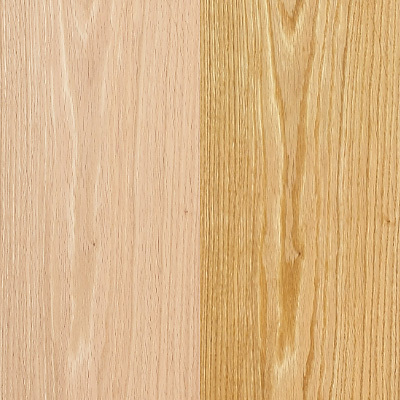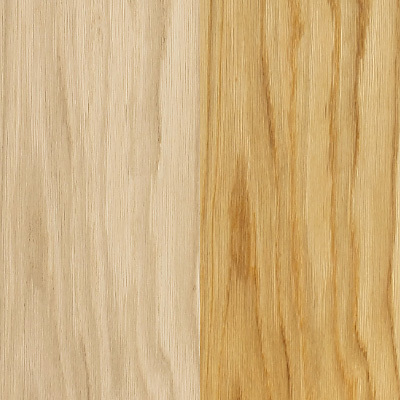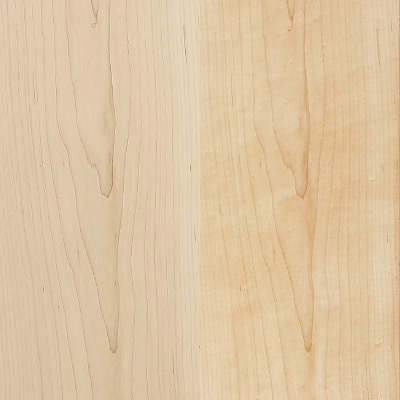About Our Wood Types
8 WOOD TYPES FOR FURNITURE THAT WILL MAKE YOUR PROJECT STAND OUT
Individuality is the name of the game in today’s home decor world. The practice of fitting your furniture choices into specific trends is ending, and buyers are finding themselves drawn toward what speaks to their personal style over what’s fashionable. With the resurgence of maximalism, Victorian, and Gothic inspired decor, there are many ways in which to personalize your own home that lets your own individuality shine.
One of the ways many furniture projects truly shine when finished is by what type of wood is used for the build. Think about those deep walnut or mahogany desks and tables tucked away in dusty antique stores. Timeless. Beautiful. Unique. Or a mid-century modern coffee table with a stunning oak frame, sturdy with clean lines and great bones.
The wood types in furniture contribute to the uniqueness and beauty of the final product. No matter what style of furniture you choose, build, or admire, one thing is for certain - a great piece of furniture starts with a great piece of wood.
There are many different aspects to take into account when choosing wood for your project - color, hardness, strength, workability, durability, finishing - the list goes on and on! Much like a snowflake, no two boards of milled wood are truly the same. A piece of authentic, hand-crafted wooden furniture isn’t going to have the same uniform appearance as a clapboard or pressboard mass-production piece, and that’s what makes it so special. Each piece is unique, just like its owner.
Here, we’re going to highlight the different types of wood for tables, table legs and more offered at Tablelegs.com. We'll cover how to best use them in your woodworking practice. All of the swatches are composed of the raw wood (left) and wood finished with clear Monocoat (all natural, plant based, VOC free and completely nontoxic oil finish) to highlight the natural grain patterns and patina of each variety of wood.
1: Walnut
A classic hardwood, walnut is used in many styles of furniture. Traditional, mid-century modern, contemporary - you name it, the versatility of walnut can get it done. Walnut often has a pronounced straight grain pattern, called the “heartwood”, that is darker than the rest of the board. Some prefer to stain the whole piece to match the heartwood, making it a uniform color. However, others opt for a clear coat finish to highlight this unique detail in their work. The choice is yours!
- 1.75" – solid stock
- 2.25" – solid stock
- 2.75" – solid stock
- 3.5" – laminated stock
- 4.5" – laminated stock
-
Solid or Laminated?
Walnut is offered as:

2: Mahogany
When you think of luxury, you think of mahogany. Synonymous with success, wealth, and power (think: the CEO’s mahogany corner desk in his top floor office), mahogany is an incredibly gorgeous and hearty wood. Its tight interlocking grains make it sturdy and very hard, making it resistant to scratches and dents. Perfect for - you guessed it! - desktops, tables, and the like. This type of hardwood is typically a bit more pricey, but is worth the expense if you’re looking for a wood that will withstand the tests of time while retaining the natural beauty mahogany is known for.
- 1.75" – solid stock
- 2.25" – solid stock
- 2.75" – solid stock
- 3.5" – laminated stock
- 4.5" – laminated stock
-
Solid or Laminated?
Mahogany is offered as:

3: Cherry
Another durable, hearty wood, cherry wood is a beautiful choice if you’re looking for a uniquely colored wood. If you own a piece of cherry furniture, you really have a few pieces in one, as the color tends to change with age and environment. When first milled, cherry is often a light yellow to salmon pink in color. As it ages, the wood grain darkens, becoming a reddish brown with a golden luster for that rustic cherry look. While it can become blotchy or bleached if left in the sun, using a wood conditioner can help keep the color you desire, especially before staining. However, like all things natural, sun bleaching is possible and probable for most woods left in a sunny window or summer porch. It’s all part of seeing the full beauty of the wood!
- 1.75" – solid stock
- 2.25" – solid stock
- 2.75" – solid stock
- 3.5" – laminated stock
- 4.5" – laminated stock
-
Solid or Laminated?
Cherry is offered as:

4: Red Oak
The red and gold tones in this wood are lighter than others in this list, and you often find it utilized in Victorian furniture for its strength, heft, and workability. Red oak is incredibly porous, which means that it absolutely soaks up and holds onto stain like a champ! If you’re looking for a solid and reliable wood that’s a little more available than some that we’ve already covered, look no further. Red oak grows all along the eastern seaboard and is often considered a high-quality and accessible hardwood for many projects!
- 1.75" – laminated stock
- 2.25" – laminated stock
- 2.75" – laminated stock
- 3.5" – laminated stock
- 4.5" – laminated stock
-
Solid or Laminated?
Red Oak is offered as:

5: White Oak
Similar to its cousin the red oak, white oak is another hard, durable, workable wood found on the Eastern shore of the United States and Canada. With a tighter grain pattern than red oak, white oak is rot resistant, one of the hardest woods. It is an excellent wood for furniture to resist scratching, denting, and damage. It can even be used for outdoor furniture. Over time, this light wood ages to a rich brown, and also accepts stain and paint wonderfully. The signature wood of Mission style furniture, white oak is an excellent choice for just about any project.
- 1.75" – laminated stock
- 2.25" – laminated stock
- 2.75" – laminated stock
- 3.5" – laminated stock
- 4.5" – laminated stock
-
Solid or Laminated?
White Oak is offered as:

6: Maple
This light colored hardwood ranges from blonde to reddish-brown that takes on a golden hue as it ages. Grain patterns of light brown to deep chocolate marble planks of this wood, and stand out best when stained or finished with a clear top coat. While most woodworking maple is referred to as “soft maple” we can assure you - it’s plenty hard! Popular in traditional, transitional, and contemporary furniture styles, maple is an ideal wood for projects where you’re looking for that individualistic touch.
- 1.75" – solid stock
- 2.25" – solid stock
- 2.75" – solid stock
- 3.5" – solid stock
- 4.5" – laminated stock
-
Solid or Laminated?
Maple is offered as:

7: Knotty Pine
Knotty pine is, as the name suggests, knotty. A knot in a board is a remnant left behind from milling, showing where the branches grew on the tree that’s been processed. Knotty pine trees, like most conifers, have quite a few branches. As a result, there are often knots present in the finished board. Colors range from a light brown to a pumpkin orange and tend to darken as the wood ages. As with coniferous wood such as knotty pine, it is lightweight and easily workable. It is very soft, making it great for carving and detail work. While pine is a popular choice for furniture, it may not be the best option if you're seeking strong wood types that will stand the test of time and maintain their brand-new appearance. That being said, knotty pine is a wonderfully characteristic wood full of beautiful details and rich variations that make it truly unique. It’s great for primitive, rustic furniture such as bureaus, cabinetry, and children’s furniture.
- 1.75" – solid stock
- 2.25" – solid stock
- 2.75" – solid stock
- 3.5" – laminated stock
- 4.5" – laminated stock
-
Solid or Laminated?
Pine is offered as:

8: Hard Maple (Table Tops Only)
Here at Tablelegs.com, we only offer our hard maple for tabletops, because we feel it’s the best use for them. Durable, a bit lighter than soft maple, with a fine, close grain texture, hard maple has a higher density and makes it a great choice for high-traffic areas such as kitchen tables. Like it’s soft maple cousin, it’s a light-colored wood with deeper heartwood marbling that is highlighted with a stain or top coat. This beautiful wood is often used for light, contemporary styles and looks lovely paired with a darker painted or stained leg.

As you can see, the choices are vast and varied for project wood. However, with Tablelegs.com, you never have to fear you’ll choose a wood that won’t work for your project! We are happy to help you find the perfect real wood planks, cuts, tops, and - of course - table legs to get you started.
FREQUENTLY ASKED QUESTIONS
How to determine wood type?
There are several ways to determine the type of wood you're working with. The first step is to observe the color and grain pattern of the wood. Use the images here to compare and find the closest match. Another option is to use a magnifying glass to examine the pores and patterns of the wood. If you're still unsure, you can consult a professional or use online resources to help identify the wood.
What is the difference between soft maple and hard maple?
Soft maple and hard maple are both species of maple trees, but they differ in hardness and density. When comparing hard maple vs soft maple, there are few things to note. Hard maple wood is harder and denser than soft maple, making it more durable and suitable for heavy use furniture. Soft maple is still a strong wood, but it is more lightweight and easy to work with, making it ideal for decorative pieces or less heavily used furniture.
What is the best wood for a table?
The best wood for a table depends on the desired aesthetic, strength, and durability of the table. Walnut, mahogany, cherry, and oak are popular choices for their durability and beauty, but other woods like maple and pine can also be great options depending on the project. Remember to consider the intended use of the table, as well as the maintenance required for each type of wood.
What is the best wood for table legs?
The best wood for table legs will depend on the design and intended use of the table. Hardwoods like oak, walnut, and maple are strong and durable options for heavier tables, while softer woods like pine can be great for decorative or lightweight tables. It's also important to consider the overall design of the table and how the wood for the legs will complement the table top.
